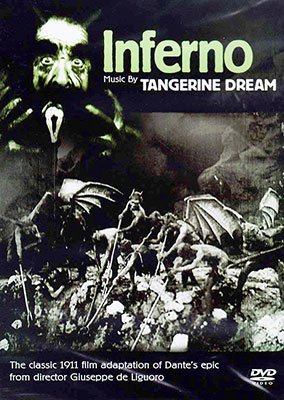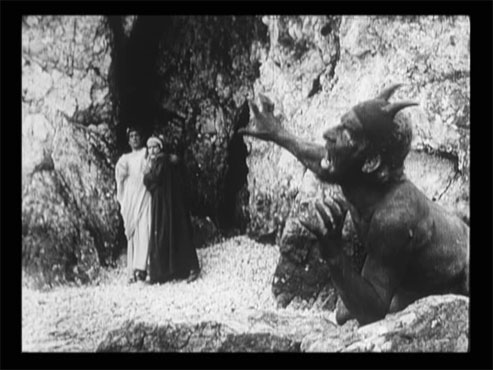
Reviews of silent film releases on home video.
Copyright © 1999-2025 by Carl Bennett
and the Silent Era Company.
All Rights Reserved. |
|
L’Inferno
(1911)
|
The ambitiousness of early Italian film production is marked in a series of grand-themed epic feature films that were produced long before the feature film took hold in Europe and America. Only the Australians had embraced the feature film before the whole-hearted dedication to the form by the Italians.
In L’Inferno (1911) we have an fine example of early epic filmmaking, for the scope of the subject matter is broad and the production is visually impressive. Themes of Italian history were often chosen in early Italian feature films to signal the solemn artistic intent of their filmmakers and to provide a more dramatic perceived context within which to mount lengthier stories. L’Inferno is no exception from this trend.
Based on the first part of Dante Alighieri’s mammoth epic poem The Divine Comedy, L’Inferno faithfully follows the source poem in its representation of the journey of the author Dante through the realm of Hell as guided by the master poet Virgil. The production design is highly-influenced by and faithful to the illustrations of Gustave Dore, and is a visual treat for the viewer.
Virgil, at the behest of the late Beatrice, leads Dante downward through the circles of Hell in a quest for spiritual enlightenment. As the eternal consequence of each dominant sin is revealed to Dante, he is in turn moved to experience a full range of human emotions from compassion to indignant anger.
In the surviving English-language release prints of L’Inferno, long expository intertitles detail for the audience the upcoming action of scenes to follow (which we can assume follow the lead of the original Italian intertitles). This was a common early filmmaking practice intended to guide the viewer through plot details that were hard to convey through gesticulation of the actors, and it was a practice that the world’s filmmakers soon abandoned for shorter titles that were instead intercut with the film’s action. Also, the original English-language L’Inferno intertitles might have been laced with more exerpts from the source text to impart some richer flavor of Dante’s poem to the viewer.
Many of the film’s ambitious visual effects are crude but well executed for 1911, including the appearance of Beatrice, the swarm of carnal sinners, the circles of grafters and the sowers of discord, and the ultimate appearance of Lucifer.
— Carl Bennett
|
 Snapper Music Snapper Music
2004 DVD edition
L’Inferno (1911), black & white, 69 minutes, BBFC Classification E.
Snapper Music, SMADVD042, UPC 6-36551-50427-0.
One single-sided, single-layered, Region 0 NTSC or PAL DVD disc; 1.33:1 aspect ratio picture in windowboxed 4:3 (720 x 480 pixels [NTSC]) or (720 x 576 pixels [PAL]) interlaced scan image encoded in SDR MPEG-2 format at 8.0 Mbps average video bit rate (capable of progressive scan upscaling to ? fps); Dolby Digital (AC3) 2.0 stereo sound encoded at 1.5 Mbps audio bit rate; English language intertitles, Italian, French, German and Spanish language subtitles; 32 chapter stops; standard DVD keepcase; £14.99/$19.98.
Release date: 11 October 2004.
Country of origin: England
Ratings (1-10): video: 7 / audio: 8 / additional content: 0 / overall: 8.
|

Utilizing 35mm materials from the Library of Congress and from the British Film Institute, edition producer Tim Pearce has compiled the most-complete surviving version of this early Italian epic film, taken largely from an American release print and presented in a windowboxed format to allow the maximum amount of the original print image to be seen on all televisions.
After a 3.5 minute introductory credits section, we view the main source print for this edition, which is of very-good quality but is compromised by some print damage common to circulated materials of this age — occasional sections of long vertical print-wear marks in the film stock, some print shrinkage which manifests in some image movement within the frame, and some picture jitters which indicates some sprocket wear and is most visible as some downward blurring in the intertitles. But the print is light on actual emulsion damage in the form of long white vertical scratches, blotches, emulsion chipping, speckling and dust, and the greyscale range is relatively broad with very-good highlight and shadow image detail. The secondary print is in better condition than the main print, but it is also notibly contrastier, with plugged-up shadows and bright highlights that lose image detail. The midshot frame geometry matching of edit points between the two source prints is very well done.
Missing from this edition is an intertitle that explains the significance of the circle of backward-walking sinners — with their heads completely turned 180 degrees around — and the complete shot of the scene itself (which here lasts for only three seconds).
Pearce scores a major artistic coup in the presentation of an original music score composed by Edgar Froese and son Jerome Froese of the famous German electronic music group Tangerine Dream. Although we respect and enjoy Tangerine Dream’s music, we felt that the English-language vocals narrating the film’s action are an unnecessary distraction and add little to the viewing experience. The vocals are somehow less disruptive when they are performed in Italian. Thankfully, such vocal intrusions are few and Tangerine Dream’s atmospheric and well-textured synthesizer instrumentals may be enjoyed for the majority of the picture.
We enthusiatically recommend this labor of love presentation of an early Italian feature film for its historical cinematic significance and its modern music score.
|
This Region 0 NTSC DVD edition has been discontinued
and is . . .
|

|
|
 Loving the Classics Loving the Classics
201? DVD edition
Dante’s Inferno (1911) [L’Inferno], black & white, 68 minutes, not rated.
Loving the Classics,
no catalog number, unknown UPC number.
One single-sided, single-layered, Region 0 NTSC DVD-R disc; 1.33:1 aspect ratio picture in full-frame 4:3 (720 x 480 pixels) interlaced scan image encoded in SDR MPEG-2 format at ? Mbps average video bit rate (capable of progressive scan upscaling to ? fps); Dolby Digital (AC3) 2.0 stereo sound encoded at ? Kbps audio bit rate; English language intertitles, no subtitles; chapter stops; standard DVD keepcase; $14.99.
Release date: 201?
Country of origin: USA
|
|
This DVD-R edition has likely been (illegally?) duplicated from the Snapper Music edition noted above.
The film is noted as accompanied by a music score composed and performed by Tangerine Dream.
|
|
This
Region 0 NTSC DVD-R edition is available directly from . . .
|

|
|
 Rare Films and More Rare Films and More
202? DVD edition
The Divine Comedy (1911) [L’Inferno], black & white, 53 minutes, not rated, with The Divine Comedy (1911) [L’Inferno], colorized black & white, 70 minutes, not rated, and Richard III (1911), black & white, 26 minutes, not rated.
Rare Films and More, 3703, no UPC number.
One single-sided, single-layered, Region 0 NTSC DVD-R disc; 1.33:1 aspect ratio picture in full-frame 4:3 (720 x 480 pixels) interlaced scan image encoded in SDR MPEG-2 format at ? Mbps average video bit rate (capable of progressive scan upscaling to ? fps); Dolby Digital (AC3) 2.0 stereo sound encoded at ? Kbps audio bit rate; Italian language intertitles, optional English language subtitles; chapter stops; standard DVD keepcase; $21.99.
Release date: 202?
Country of origin: USA
|
|
This DVD-R edition has likely been mastered from files lifted from an Internet streaming site or from another company’s home video edition.
The film is presented with Italian narration likely pirated from another company’s home video edition or a soundtrack compiled from preexisting music recordings.
Note that this company apparently has a history of pirating other home video editions to produce their products. Be aware that purchasing pirated home video editions does not benefit the original edition producers nor the composers whose music is often pirated as well.
|
|
This
Region 0 NTSC DVD-R edition is available directly from . . .
|

|
|
|
Other ITALIAN FILMS of the silent era available on home video.
Other HORROR FILMS of the silent era available on home video.
Other EARLY FEATURE-LENGTH FILMS of the silent era available on home video.
|
|
View a trailer for this home video edition at the L’Inferno website.
|
|




































